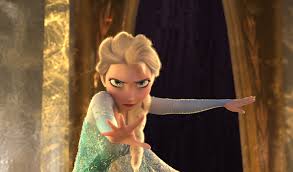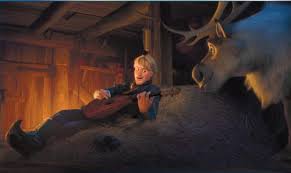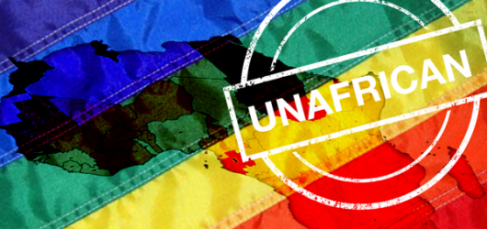Disney’s latest princess film, Frozen, is clearly about repression: the fear that leads to it, the pain it causes, and ways of escaping it. But what kind of repression are we talking about here? I will begin by discussing one of the most popular interpretations, which is that Frozen is a tale of gay liberation. This reading, I will argue, is compelling but limited. I will then suggest that, if we return our focus to the key dynamic of generalised (rather than sexual) repression, we can see the film as dramatising the arc of psychological damage wrought by intense repression. While the film can absolutely be taken as promoting standard American individualist teachings about self-acceptance, we can also find in it an exploration of some of the most extreme effects of repression, namely, schizoid and schizophrenic reactions. While the film teaches the blandly acceptable lesson that you should “be yourself,” it contains a chilling “or else,” in which the film explores one of the most severe reactions to repression: schizophrenia.
When I first watched Frozen, I instinctively read it as queer—and a quick search proved I was not at all alone. Along with criticism of the film’s whitewashing—including the appropriation of Sami cultural symbols without the inclusion of any Sami characters—and straightforward feminist readings, queer readings of Frozen feature strongly in online commentaries.
Devin Faraci writes, “I think there’s certainly a valid queer reading to be found in the film,” while Eric Diaz is even more definite: “Frozen’s subtext is so gay, it’s barely subtext!” Elsa “was born this way,” but her parents teach her that her difference is dangerous and shameful, requiring isolation and concealment. When, in a moment of passion, she inadvertently reveals her difference, she is forced to flee, at which point she learns to love herself, and builds an ice castle which Diaz likens to “She-Ra’s Crystal Castle…In a movie filled with gay stuff…this might be the gayest part of all.”
The song “Let it Go,” with its images of release and dazzling self-discovery, functions strongly as a coming out song, as well as a song about other forms of non-normative self-acceptance. As Diaz writes, “ ‘Let it Go’ is pretty much the gay kids’ coming out anthem for a generation. Seriously, expect a whole gaggle of musical theatre kids to belt this number out in audition after audition…for like, the next 30 years.” By the end of the song, Elsa has shed her buttoned-up look and become a strutting diva in a sparkly cocktail dress, which R. Kurt Osenlund calls “unmistakably drag-esque—a self-styled fabulation.” This ice queen is hot, and she’s doing it for her own delight. Some have quite legitimately criticised the unrealistic and excessively sexualised nature of her empowerment, but looking at her, I’m tempted to say that she’s not a woman, she’s a femme. 
As we consider the nature of Elsa’s gender and sexuality, we must note that, very unusually for a Disney princess (though not so much, perhaps, for a Disney queen), Elsa has no romance plot. This, I feel, is the most distasteful nudge towards a lesbian reading. While we could certainly accept Elsa as asexual—as many have suggested—it feels like queerbaiting to read the lack of heteronormative desire as a stand-in for lesbian desire. A search for ‘asexuality’ and Frozen produces approximately 800,000 results, but a search for ‘gay’, ‘lesbian’ or ‘queer’ and Frozen yields several million results: clearly, sexual readings are dominant. Lodged within the reading of Elsa as lesbian, however, is a hint of incest—largely unacknowledged beyond femslash fandoms because it is so inadmissible, despite its obvious subtextual presence.
Love for Anna dominates Elsa’s life; Elsa’s icy explosion is motivated by news of her sister’s engagement; Anna’s rescue of Elsa from her tower maps onto a princely quest á la “Rapunzel” or “Sleeping Beauty;” and it is Anna’s love for her sister that saves both of them. Sisterly love is prioritised through romantic tropes in a film in which the potentially lesbian lead lacks any love interest—except her sister. Lesbianism, here, becomes either a perversion or a neutered BFF/LYLAS sleepover.
While aspects of the film point us towards a gay reading of Frozen, this interpretation remains incomplete and unsatisfying. Much more productive is Angeline Daniel Matos’ suggestion that we apply a broader understanding of queer theory, one which is not about sexuality so much as the dismantling of binaries and the “disruption of unnecessary regulations that prevent people from achieving a liveable life.” This is a strong reading, and one to which we will return. Nevertheless, I wondered why I leapt to a lesbian reading so easily and stick to it so doggedly—and, indeed, why this has become such a broadly discussed and even accepted aspect of the film.
We make this jump, I think, because the form of repression that our society is currently most interested in is the repression of queer sexualities. When we watch Elsa in her dynamics of repression and release, therefore, it triggers narratives of closeting and coming out, despite the lack of much further evidence or any follow through. The gay subtext is present but, I would argue, ultimately stunted and limiting, as any gay subtext will be: a film can only be so liberated if it remains stuck in the celluloid closet.
More important is the underlying dynamic of repression and release. By focusing on that dynamic, I’ll argue, we can read Frozen as an exploration of one of the most damaging psychological forms of repression: schizophrenia. In reading Frozen as a story about schizophrenia, I’ll primarily be following R. D. Laing’s theory as developed in The Divided Self. According to Laing, schizophrenia develops out of a fundamental insecurity: a person feels utterly unable to exist as themselves in the world—they may feel rejected by their parents, or they may develop a sense of themselves as bad and dangerous.
To protect both themselves and others, they build up defensive walls around their ‘true’ nature, striving to keep up a compliant façade. Away from this false-self, they retreat deep into their own fantasy worlds, where they are omnipotent and they can create their own companions. A private fantasy kingdom, wholly cut off from reality, is not a viable escape, however: it is fragile, destructive, and unsustainable. From this summary, it should be fairly easy to see how Elsa’s narrative maps onto Laing’s theory of schizophrenic development.
Frozen readily lends itself to being read as a schizophrenic fairytale, symbolically dramatising the terrors, torments and tactics of the schizoid personality. Let’s take a moment to trace this narrative more explicitly. As a child, Elsa accidentally strikes her sister Anna with her ice-magic.
Her father is savvy enough to rush them to a troll sage, who cures Anna and declares that Elsa’s powers could become dangerous unless she learns to control them. Her father, reasonably enough, decides that this means he should lock her away from everyone, including her sister, so that she won’t be able to hurt anyone and no one will ever find out. Elsa’s self-suppression is thus firmly rooted in guilt and fear, and is explicitly demanded and cultivated by her parents.
Laing has been criticised for what some see as an excessive emphasis, particularly in his later work, on the causative role of parents in the development of schizophrenia—but this royal couple are acting out his theories with a gusto! Into adulthood, Elsa coaches herself in self-control by addressing herself in second person and mimicking her finger-wagging father: “Don’t let them in, don’t let them see./Be the good girl you always have to be./ Conceal, don’t feel, don’t let them know.” These commands from her controlling father have become part of what Laing calls her ‘false-self system’. Her tight, formal clothes, hair and manner are attempts to disguise both her difference and her vulnerability.
Even the castle, closed to the world, becomes an extension of Elsa’s false-self system, recalling an image from Laing: “If the whole of an individual’s being cannot be defended, the individual retracts his lines of defense until he withdraws within a central citadel.” Her relationship to her true self is so underdeveloped and insecure that she must try to compensate through excessive rigidity. As Laing notes, however, in such a situation much of the danger comes not from the perceived threat itself but from “the devastation caused by the inner defensive maneouvres themselves.”
Driving all of these desperate, painful operations is Elsa’s fear of hurting her sister. Love and contact have become impossibly dangerous for her. Laing writes,
If there is anything the schizoid individual is likely to believe in, it is his own destructiveness. He is unable to believe that he can fill his own emptiness without reducing what there is to nothing….[His isolation] is out of concern for others. A schizophrenic patient would not allow anyone to touch her, not because they would do her some harm, but because she might electrocute them….He descends into a vortex of non-being in order to avoid being, but also to preserve being from himself (93).
For Elsa, of course, the psychotic/fantastic manifestation of this fear is her freezing touch: she jolts back terrified as the windowsill bristles with ice beneath her hands, and she flinches away from her parents’ attempted comfort crying, “Don’t touch me! I don’t want to hurt you.”
She absorbs into herself the harm being done to her: the parents whose efforts at care are destroying her become the ones she cannot touch for fear of causing hurt. Her attempt at courage and love becomes hurtful and desolate. Anna, the one who most delights her, who literally awakens her, is the focus of the greatest fear, of course: with Anna, she is most herself, and thus it is Anna she can harm most deeply and must shut out most totally.
Trapped within this castle of alienation, even Anna becomes unbalanced through loneliness and isolation. She attempts to sustain herself through schizoid relationships with the castle’s paintings, which she speaks to, inhabits and sees moving. Her sister has become, for her, a wall, a closed door. Elsa’s own starved psyche can be seen clearly in the image which closes Anna’s song “Do You Wanna Build a Snowman?”: Elsa sits motionless against the door in a room blasted with shocks of frost. In Laing’s words, “Love is precluded and dread takes its place. The final effect is an overall experience of everything having come to a stop. Nothing moves; nothing is alive; everything is dead, including the self” (82). Pain, fear and guilt freeze her into catatonia.
Elsa’s own starved psyche can be seen clearly in the image which closes Anna’s song “Do You Wanna Build a Snowman?”: Elsa sits motionless against the door in a room blasted with shocks of frost. In Laing’s words, “Love is precluded and dread takes its place. The final effect is an overall experience of everything having come to a stop. Nothing moves; nothing is alive; everything is dead, including the self” (82). Pain, fear and guilt freeze her into catatonia.
At the coronation, Elsa’s protective false-self system is shattered by Anna’s impulsive need for contact and connection. Elsa’s magical rage is precipitated first by Anna’s hasty engagement; then by Anna’s demands for honest (and public) communication; and finally by Anna grabbing Elsa’s hand, tearing away a glove.
The gates are open, the castle is full, the foreign prince has claimed her sister, and the gloves are coming off. On one level, we might even read the sisters as conflicting elements within one person: terrified isolation from the world breeds a ravenous longing for it. Anna’s instantaneous absorption in Hans is the counterpart to Elsa’s reflexive refusal to be drawn into a dance with the world. Together, the sisters embody an ambivalence which Laing identifies as typical of schizoid attitudes towards the world:
The abundance there is longed for, in contrast to the emptiness here; yet participation without loss of being is felt to be impossible, and also not enough, and so the individual must cling to his isolation—his separateness without spontaneous, direct relatedness—because in doing so he is clinging to his identity. His longing is for complete union. But of his very longing he is terrified, because it will be the end of his self (92).
Anna moves seamlessly from inserting herself into romantic paintings to spinning a fairy tale romance with the willingly deceptive Hans, who exemplifies another, non-schizoid form of false-self system. It is the conflict between Anna’s longing for “complete union,” not only with Hans but the kingdom and the world, and Elsa’s need to protect herself that finally destroys Elsa’s false-self system, exposing her flesh, her powers and her unacceptable truth.
From good to bad to mad: such is the typical schizoid journey, according to Laing. Pushed too far, the poised Elsa explodes with a bristling fence of icy spikes; she is declared a sorceress and a monster, then flees across the sea on a trail of ice.
Her escape into the wilderness can be seen as an extreme retreat into inner space. Her previous isolation within the castle actually held her in a furious, unendurable state of tense relatedness to the world as she strained to maintain a role and position without revealing her true self. Running into the wilds is an attempt to reject this unsustainable contradiction.
Once the impossible equilibrium is broken, she renounces all relatedness and surrenders her place in the world. Fleeing into the wilderness has a deep, global association both with magic and madness, two forces which are often understood to be closely intertwined. In the wilderness, a person is no longer forced to occupy social roles, the maintenance of which always demands a certain amount of control and dissemblance from even the sanest of us.
Elsa discovers affinities between the wilderness and her inner space: “The wind is howling like the swirling storm inside./ Couldn’t keep it in, Heaven knows I tried.” At this point, it will be
helpful to draw in elements from Gilles Deleuze and Félix Guattari’s rather different theories of schizophrenia, which they understand as creating a resistance to social roles and performance in favour of a mode of existence which is wilder, fiercer and more flexible. In this schizophrenic mode, experience is characterised by ‘intensities’: sensations and forces which flow across the body. The whole world, the self included, is traversed by flows of intensities: energy which passes, changes, manifests as matter and dissolves again into energy. Deleuze and Guattari emphasise the connections between this intense schizophrenic self and wildernesses, which they refer to as “smooth spaces.”
The schizophrenic experiences themselves as vividly part of smooth spaces flowing with intensity: electricity, light, sound, water, wind.
In Elsa’s case, her characteristic intensity is ice. For years, she has kept the flows of ice blocked within her. Now, in the wilderness, her inner turmoil becomes just another part of the storm, and she feels herself “one with the wind and sky” (“Let It Go”): in this state, her powers can flow out into the world unchecked. She begins to fully explore the intense potentialities of her condition, racing across this unlimited space, “to test the limits and break through./ No right, no wrong, no rules for me”: she has moved into an amoral creative union with smooth space.
After keeping her ‘true’ self walled-up for so long, she finally feels her “soul…spiraling in frozen fractals all around,” as she manifests her internal reality, creating a soaring, magnificent castle of ice. Rather than stone and straight lines, she now inhabits the chaotic patterns of fractals, with their partial dimensions.
Here, however, we might begin to sense renewed trouble. Her freedom has manifested in yet another soul-castle, which, like the castle in Arrendell, establishes powerful solitude. She has escaped from an unbearable reality into a magical realm in which she is omnipotent—yet she fails to break through any limits; she simply recreates the same palatial isolation that she has always known. Omnipotence, Laing threatens, can only ever be an impotent fantasy.
 At the same time, her retreat into the wilderness of fantasy is not without consequences, as she believes: Arrendell has been plunged into winter. The schizoid attempt to replace the real world with an inner world is doomed, Laing asserts:
At the same time, her retreat into the wilderness of fantasy is not without consequences, as she believes: Arrendell has been plunged into winter. The schizoid attempt to replace the real world with an inner world is doomed, Laing asserts:
The individual is developing a microcosmos within himself, but, of course, this autistic, private, intra-individual ‘world’ is not a feasible substitute for the only world there really is, the shared world. If this were a feasible project then there would be no need for psychosis (75).
Elsa’s ‘psychotic break’ with the kingdom has frozen it. If we return to the kingdom as a symbol of this queen’s outer self (the ‘public body’ of the queen, perhaps), then her abandonment of external for internal reality has resulted in a catatonic ‘freezing’ of that outer self. Not incidentally, catatonic schizophrenia, in which the sufferer seems to entirely shut down, becoming unresponsive and even motionless, is also known as ‘frozen schizophrenia.’
The isolation is unallowable: it offends not only repressive norms but any urge towards life. Elsa’s palace is penetrated first by Anna’s compassion and then invaded by soldiers bent on her destruction—it is difficult, from her position, to tell the difference.
She creates a giant snow golem to protect herself—the inverse of her earlier whimsical creation of Olaf, the ‘loveable’ snowman who longs for summer and likes “warm hugs.” These icy desires for warmth are overwhelmed by her ferocious defensive response: the golem temporarily overpowers Olaf, and Elsa’s icy blasts accidentally hit Anna again, this time in the heart. In the storming of the ice palace, Elsa’s two classically schizoid fears are realised: she is invaded and shattered, and she also becomes the fatal force she’s always feared herself to be.
We can also note here that Kristoff mirrors Elsa’s tendencies, although without the same psychotic intensity. One Tumblr user, Frozenmusings, has joked that Kristoff is “boarderline schizophrenic” (sic) because he speaks ‘for’ Sven the reindeer. This joke is extended when he introduces Anna and Olaf to his family: a field of rocks. Olaf, himself a figment of Elsa’s psychosis, actually whispers, “He’s nuts!” and advises Anna to make a run for it. This is an odd moment. Although we, the audience, know that the rocks will become trolls, Kristoff begins speaking to them, apparently holding a conversation, before they have actually assumed their troll forms. Once they do manifest, their flood of greetings suggest that they were not actually party to the earlier ‘conversation’.
This momentary dissonance highlights a schizoid strangeness within Kristoff: a solitude and suspicion of others, as well as a preference for relating within fantasy worlds, speaking more readily to rocks or his reindeer than to other people.
As he sings in the persona of Sven, “people will beat you and curse you and cheat you/Every one of them’s bad except you” (“Reindeers are Better than People”). The trolls, who are the very embodiment of energetic social engagement and communal embeddedness, recognise his relationship with Sven as odd, listing one of his flaws as “That thing with his brain, dear./His thing with that reindeer/Is a little outside of nature’s laws” (“Fixer Upper”). Deleuze and Guattari also note that the schizophrenic is a psychological orphan, rejecting the Oedipal restrictions of ‘mommy-daddy-me’: schizophrenics speak of being their own parents, of being parentless, of manifesting out of swarms, out of the wilds. Thus, we find Elsa the orphan and Kristoff the orphan raised by a pack of magical rocks.
Even these rock people are warmer, by far, than Kristoff, who first appears coated in snow and whose trade in ice is no accident: note how he regards Elsa’s ice palace with a connoisseur’s admiration.
These isolated souls, however, are, according to Disney, just in need of some loving acceptance. Of Kristoff, the trolls sing that “His isolation is confirmation/Of his desperation for human hugs” (“Fixer Upper”)—a line which also, incidentally, stresses the need for human rather than magical relatedness. You cannot settle with a family of rocks or a kingdom of snow. In this Disney telling of schizoid healing, for Elsa as well as Kristoff, the resolution is swift, neat and—internally—almost effortless. They must suffer imprisonment and betrayal, and battle across icy wastes—as their coping mechanisms fall into collapse—but once the power of Anna’s love manifests itself, Kristoff finds the courage to open his heart, and Elsa’s false-selves and isolating fantasies melt into loving connectedness.
She opens the kingdom to beneficial contact, and she has gained a creative control over her intensities. She is able to provide Olaf, that avatar of her childish desire for summer and hugs, with just the right degree of separateness to facilitate his experience of warmth while maintaining his individual integrity: “My own private flurry!” She no longer has to escape into the wilderness to move freely: rather, she is able to temporarily transform the city square into a smooth space across which she and the citizens can delightedly glide. As Matos writes, this happily ever after is facilitated by a broad queerness: binaries collapse, so that hot and cold, public and private, can coexist. The binary becomes, instead, a polarity: the yin and yang which not only can coexist, but must, in an intimate interdependence.
To Thus, Frozen escapes from the sterile tensions of contradiction to the magical fertility of paradox—“A sunny pleasure-dome with caves of ice,” to quote Coleridge. What does this conclusion suggest for schizophrenia? Love, compassion and acceptance are, clearly, the antidotes to repression and the guilt and hate it breeds. More deeply, though, the ‘cure’ for madness may be a communal embrace of it. The Duke of Weselton, who demonizes Elsa as a monster or witch must himself be expelled: Arrendell’s opening and thawing depends on its embrace of magic and madness, and the paradoxical joy and wisdom this can bring.




















